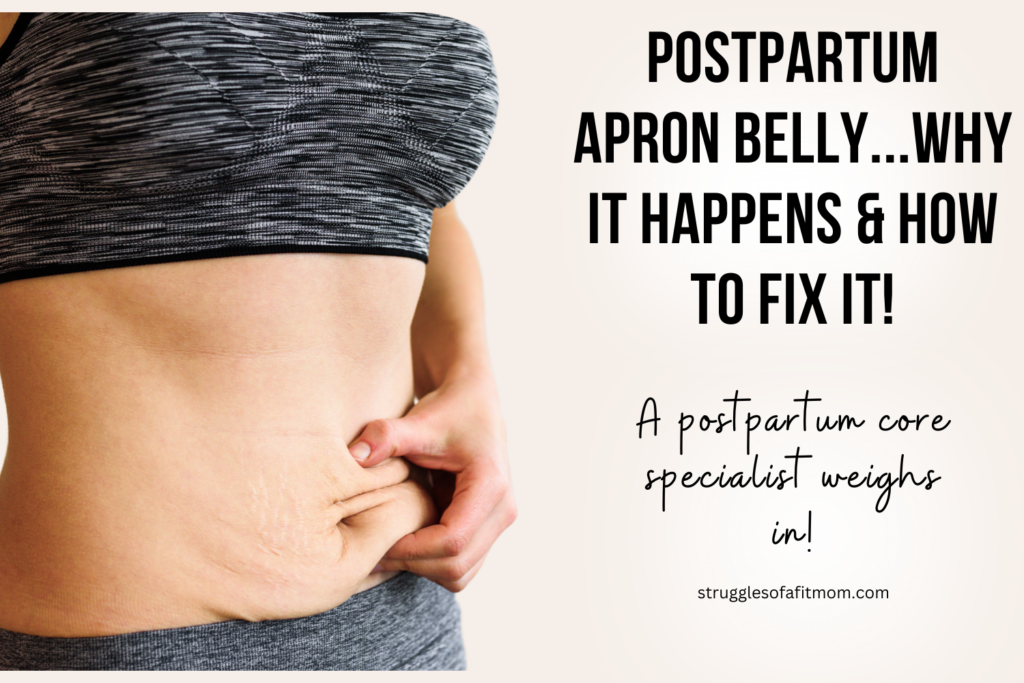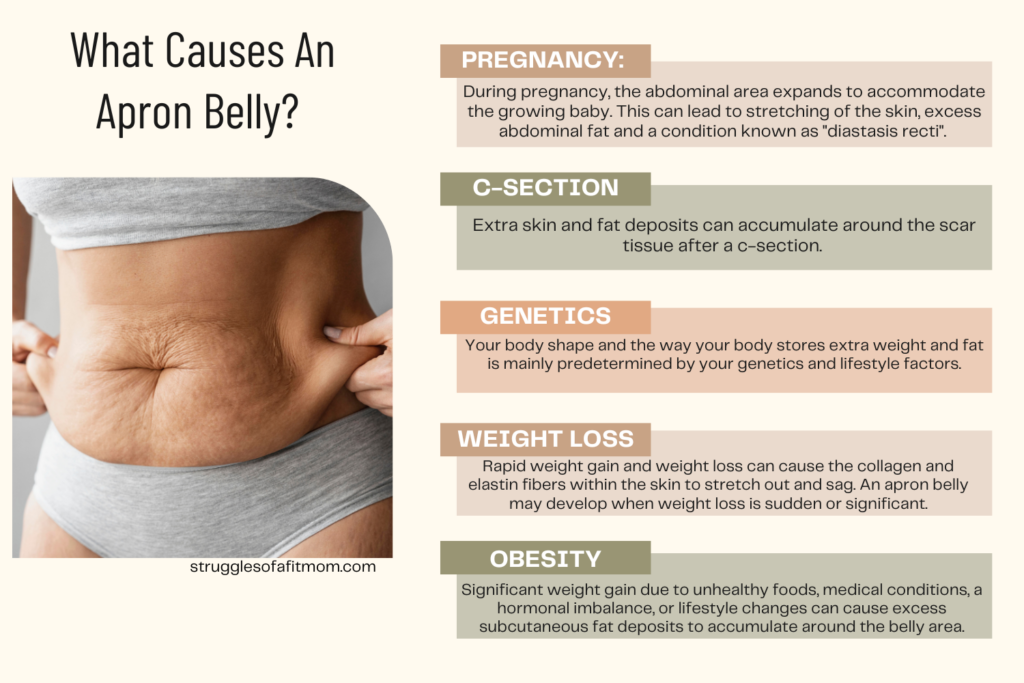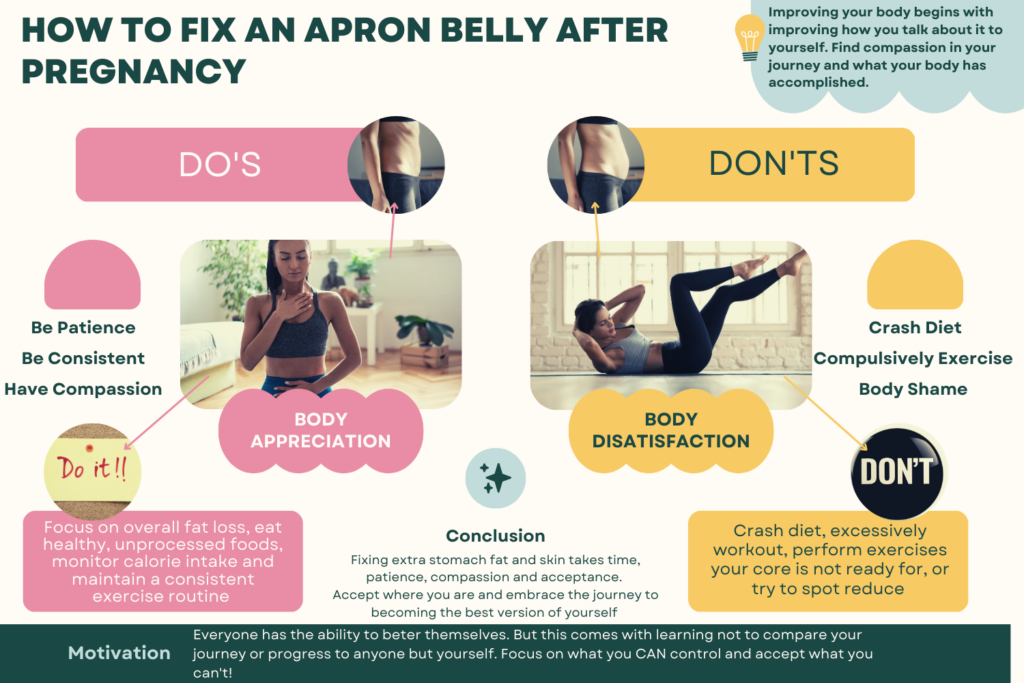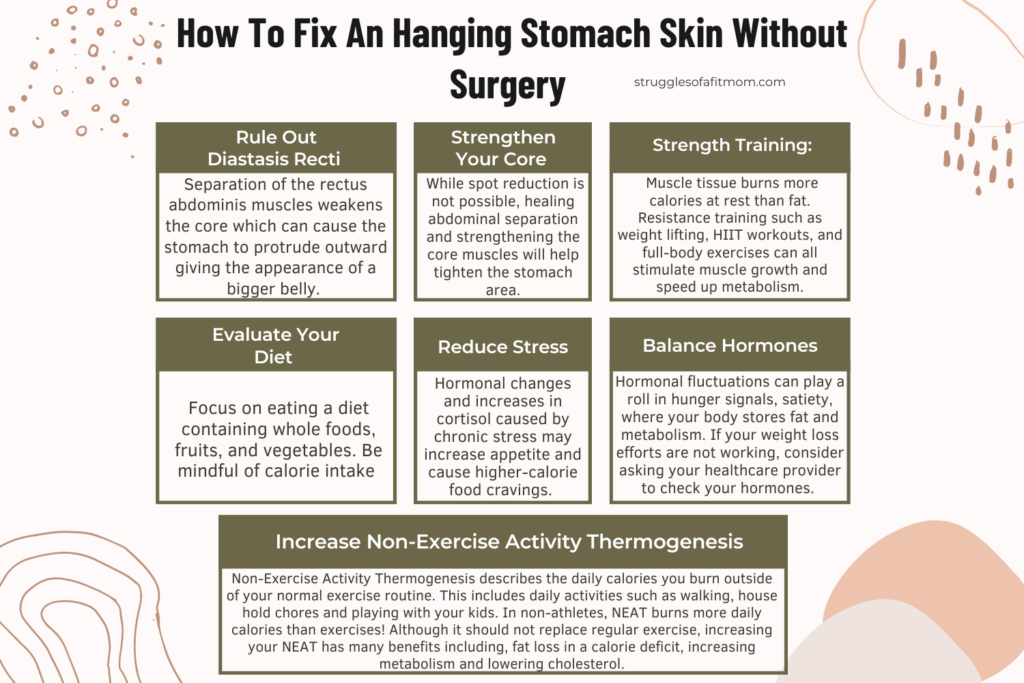Say Goodbye to Apron Belly: The No-Surgery Solutions
(This post probably contains affiliate links. I receive a small commission at no cost to you through links shared on this website to help keep the information I provide free to you)
If you have noticed an excess amount of skin, or a layer of fat that hangs below your abdomen, you may be experiencing something referred to as an “apron belly.”
It’s a common frustration for many women, especially after giving birth.

But even if you’ve never had children, you can still end up with a pooch that won’t go away, no matter what you do.
But there is hope!
With the right exercises and lifestyle changes, you can start seeing progress towards a flatter stomach without having to resort to surgery.
Let’s dive in with what a so-called apron belly is.
What is An Apron Belly?
An apron belly, abdominal apron, mother’s apron, or pannus stomach refers to an overabundance of visceral fat and extra skin, that hangs down over the top of the pubic area.
This accumulation of excess weight and body fat often leads to a large apron-like flap under the abdominal muscles and in front of the intestines.
Apron bellies can affect both men and women of all shapes, sizes however it is a very common complaint from moms after pregnancy.
What Causes It?
Several factors including genetics, obesity, massive weight loss, and pregnancy can all contribute to apron belly fat.
Below is a more in-depth explanation of each of the causes and how they can contribute to this condition.

Is It Possible To Get Rid of an Apron Belly?
Getting rid of an apron belly will likely depend on what caused the excess skin and stubborn fat in the first place.
While there is no way to specifically target stomach fat , overall weight reduction through healthy eating and physical activity can help the appearance of your stomach area.
However, despite implementing lifestyle changes, your sagging skin may still remain.
Surgical removal is typically the only way to eradicate this problem completely.
For aesthetic reasons, a surgical procedure, like a tummy tuck or panniculectomy, can be done by a plastic surgeon to remove your excess skin and apron belly fat.
But keep in mind that cosmetic surgery can be extremely extensive, expensive, and risky.
Talk to your doctor to find out if you are a good candidate for a cosmetic procedure.
Non-surgical options like cool sculpting or a fat-melting laser procedure are also available and tend to be less invasive.
How To Reduce an Apron Belly After Pregnancy?
Unfortunately, one of the the side effects of pregnancy can be the development of stretched or excess skin and an accumulation of fat around the midsection.
This can lead to a condition called, “diastasis recti”.
If you have significant postpartum abdominal separation, many ab exercises can actually make you belly look bigger.
And while you may be tempted to focus on “toning” your stomach area, spot reduction is not possible.
The best way to reduce or get rid of this extra baggage around your midsection is with overall weight loss through a healthy diet and consistent exercise routine.

How To Reduce an Apron Belly After Rapid Weight Loss?
Unfortunately, rapid weight loss can cause loose skin.
In this case, the stomach overhang will contain less fat and more sagging skin.
Surgical options like a panniculectomy or tummy tuck are usually the only permanent options for removing the excess skin.
If surgery isn’t an option for you, a support band or compression garment are a great way to help support and/or hide your apron belly which will improve both comfort and improve your self-esteem.
Related: Unlock Your Weight Loss Success With These 80 Affirmations
Will Losing Weight Get Rid of a Hanging Belly?
Losing weight may help improve the appearance of your hanging belly, however, there is no way to spot-treat this condition.
Even with dietary changes and weight loss, loose skin can still be an issue.
Here Are Some Tips to Reduce an Apron Belly Without Surgery:
Related: Healing Your Core After Pregnancy-Everything You Need To Know
Related: Never Diet Again-How Calorie Cycling Works for Weight Loss

Is It Possible To Prevent an Apron Belly During Pregnancy?
Preventing excess skin and abdominal fat during pregnancy boils down to genetics and lifestyle habits.
The best way to reduce your risk of developing excess skin and fat is to minimize excess weight gain, keep your core strong and eat a well balanced diet.
Unfortunately, even with a healthy lifestyle, an apron belly can still develop from pregnancy.
While weight gain during pregnancy is necessary, here are a few easy ways to prevent excess weight gain during pregnancy:
- Stay active
- Manage stress
- Get enough sleep
- Increase protein intake
- Drink plenty of water
Related: How To Exercise During Pregnancy-Everything You Must Know
How Long Does It Take To Lose an Apron Belly After Pregnancy?
The time it takes to lose an apron belly after pregnancy will depend on many factors and will vary from person to person.
But generally, it can take anywhere from 4-6 weeks for your belly and uterus to return to normal after pregnancy.
Losing an apron belly should be a multi-faceted approach that aims to improve overall well-being and should include a good diet and exercise regime.
You cannot spot-treat an apron belly and your goal should be overall all fat loss and building strength.
Other factors like genetics, hormonal changes, and the severity of your apron belly will affect the time required to improve it.
What Are The Health Consequences of Having Extra Belly Fat?
There are several dangerous health risks to having extra belly fat, including an increased risk for diabetes, certain cancers like ovarian cancer, heart disease, and liver disease.
Excess belly fat, like in an apron belly, is especially dangerous because the extra layers of fat accumulate around your vital organs.
Aside from this, an apron belly can cause back pain, skin rashes, irritation, chafing, and physical and emotional discomfort.
Be sure to practice good hygiene by keeping the affected area clean and dry.
Anti-fungal powders are a great option for maintaining the area and keeping it free from infection.
How Can I Hide Loose Skin on My Belly?
Shape wear, support bands, and compression clothing can all help cover up an apron belly, help support loose sagging skin, and ease the physical discomfort associated with it.
Final Thoughts on Natural Ways to Get Rid of an Apron Belly
An apron belly can occur for many reasons, but the good news is there are plenty of things you can do to fix it.
It is always a good idea to check with your doctor to ensure you do not have any underlying medical reasons that could be contributing to your weight gain.
The best thing you can do is focus on your diet, stay physically active to remove the extra fat.
But most of all, stay patient with yourself!
Whether the loose skin is a result of pregnancy or weight loss, either way, your body has accomplished something amazing and you should be very proud of your success!
Those who are unable to lose fat in the target area may opt for non-surgical/surgical procedures to remedy the issue and improve their mental health.
FACT CHECK
Struggles of a Fit Mom uses only high-quality sources, including peer-reviewed studies, to support the facts within it’s articles. Read my editorial process to learn more about how I fact-check and keep my content accurate, reliable, and trustworthy.
Bullmore, H. (2022, August 17). What is non-exercise activity thermogenesis (NEAT)? livescience.com. https://www.livescience.com/What-is-non-exercise-activity-thermogenesis-NEAT
Content – Health Encyclopedia – University of Rochester Medical Center. (n.d.). https://www.urmc.rochester.edu/encyclopedia/content.aspx?contenttypeid=134
Ramírez-Campillo, Rodrigo et al. “Regional fat changes induced by localized muscle endurance resistance training.” Journal of strength and conditioning research vol. 27,8 (2013): 2219-24. doi:10.1519/JSC.0b013e31827e8681


Brooke is a certified Prenatal and Postnatal Exercise Specialist with a Bachelors of Science degree in Kinesiology-Exercise Science. She is also a mom of 3 girls with more than 15 years of experience in health and fitness. Brooke’s goal at Struggles of a Fit Mom is to help motivate, educate and inspire other busy mamas who struggle with finding time, energy and motivation to take care of themselves in the chaos of motherhood.




![9 Very Outdated Weight Loss Tips [that suck]](https://www.strugglesofafitmom.com/wp-content/uploads/2019/07/stroller-workout-for-toned-legs-copy.jpg)


![8 Tips To Make Your Days a Breeze [as a Stay at Home Mom]](https://www.strugglesofafitmom.com/wp-content/uploads/2020/09/Blank-450-x-450.png)
